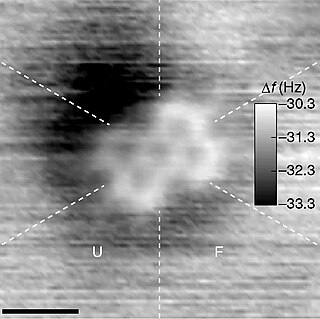The molecular formula C9H12O (molar mass: 136.19 g/mol, exact mass: 136.0888 u) may refer to:
- Mesitol (2,4,6-trimethylphenol)
- 2,3,6-Trimethylphenol
The molecular formula C9H12O (molar mass: 136.19 g/mol, exact mass: 136.0888 u) may refer to:
A chemical formula is a way of presenting information about the chemical proportions of atoms that constitute a particular chemical compound or molecule, using chemical element symbols, numbers, and sometimes also other symbols, such as parentheses, dashes, brackets, commas and plus (+) and minus (−) signs. These are limited to a single typographic line of symbols, which may include subscripts and superscripts. A chemical formula is not a chemical name, and it contains no words. Although a chemical formula may imply certain simple chemical structures, it is not the same as a full chemical structural formula. Chemical formulae can fully specify the structure of only the simplest of molecules and chemical substances, and are generally more limited in power than chemical names and structural formulae.

A molecule is an electrically neutral group of two or more atoms held together by chemical bonds. Molecules are distinguished from ions by their lack of electrical charge.
In chemistry, the molar mass of a chemical compound is defined as the mass of a sample of that compound divided by the amount of substance in that sample, measured in moles. The molar mass is a bulk, not molecular, property of a substance. The molar mass is an average of many instances of the compound, which often vary in mass due to the presence of isotopes. Most commonly, the molar mass is computed from the standard atomic weights and is thus a terrestrial average and a function of the relative abundance of the isotopes of the constituent atoms on Earth. The molar mass is appropriate for converting between the mass of a substance and the amount of a substance for bulk quantities.
The molecular formula C2H6O (molar mass: 46.07 g/mol, exact mass: 46.04186 u) may refer to:
The molecular formula C6H8O6 (molar mass: 176.124 g/mol) may be:
The molecular formula C13H16N2O2 (molar mass : 232.27 g/mol, exact mass : 232.121178) may refer to:
The molecular formula C2H6OS (molar mass: 78.13 g/mol, exact mass: 78.01394 u) may refer to:
The molecular formula C5H4N4O (molar mass: 136.11 g/mol, exact mass: 136.0385 u) may refer to:
The molecular formula C5H12O4 (molar mass: 136.146 g/mol, exact mass: 136.0736 u) may refer to:
The molecular formula C6H6O4 (molar mass : 142.10 g/mol, exact mass : 142.026608 u) may refer to:
The molecular formula C6H10N2O2 (molar mass: 142.16 g/mol, exact mass: 142.0742 u) may refer to:
The molecular formula C10H16 (molar mass: 136.24 g/mol) may refer to:
The molecular formula C7H6O2 (molar mass: 122.12 g/mol, exact mass: 122.036779 u) may refer to:
The molecular formula C11H15NO2 (molar mass : 193.24 g/mol, exact mass : 193.110279) may refer to:
The molecular formula C8H12N2 (molar mass: 136.19 g/mol, exact mass: 136.100048) may refer to:
The molecular formula C6H6N4O4 (molar mass: 198.136 g/mol) may refer to:
The molecular formula C7H8N2O (molar mass: 136.154 g/mol, exact mass: 136.0637 u) may refer to:
The molecular formula C136H210N40O31S (molar mass: 2933.43 g/mol, exact mass: 2931.581 u) may refer to:
Trimethylphenol may refer to:
2,3,6-Trimethylphenol is an organic compound with the formula (CH3)3C6H2OH. As a precursor to vitamin E, it is the most widely used of the several isomers of trimethylphenol.